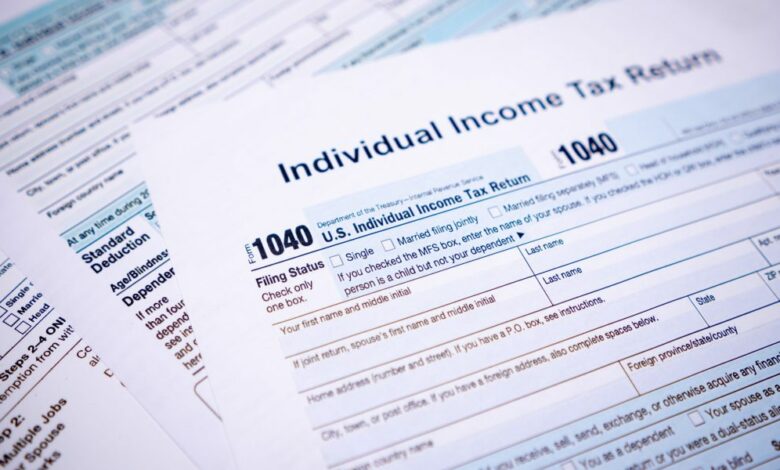7 tax tips to make sure you get the biggest refund, according to financial advisors


With less than two months to go until 2023 taxes are due, there is still plenty of time to lower your bill or maximize your refund, advisors say. It’s also the perfect time to look ahead to decreasing your burden for 2024.
Firstly, it’s important to make sure you have all of the documents you’ll need to file, advisors say: That’s W2s and 1099s, yes, but depending on your situation, also 1099-INTs (for interest payments), 1099-Gs (for unemployment payments) and SSA-1099s (for Social Security payments), to name just a few. It’s also important to gather all required documents as soon as possible.
“Waiting until the last minute can lead to unnecessary stress and potential errors,” says Ashton Lawrence, a South Carolina-based CFP at Mariner Wealth Advisors.
From there, review the big changes for 2023, Lawrence suggests. Pretty much all of the COVID-19-related tax changes and benefits weren’t in place last year, which means your refund could be very different from the past few years. Also, the standard deduction, tax brackets, and retirement contributions have all changed.
Then you’re ready to get started. Here are some additional tips from financial advisors on making filing simple and maximizing your refund. (And don’t miss Fortune‘s other tax season coverage.)
1. Max out your 2023 retirement accounts
If you haven’t done so already, you still have time to contribute to a traditional or SEP IRA and reduce your tax. Each year, you have until the filing deadline—April 15, 2024 this year—to max out your contributions.
The max for a traditional IRA last year was $6,500 ($7,500 for those 50 and up) while the max for SEP IRAs, used by some business owners, is much higher—the lesser of 25% of compensation or $66,000.
“These accounts can offer tax-deferred growth on top of pre-tax contributions that can set you up well for retirement and save you a lot on taxes right now,” says Bryan Cassick, a CFP at California-based Warren Street Wealth Advisors.
Just make sure to classify your contribution as a prior-year contribution—otherwise, your IRA provider will likely classify it is as a current-year contribution. You also have until April 15 to max out a Roth IRA for 2023; that won’t lower your tax bill now, but it can help you build your savings.
All that said, you can also begin planning 2024. Though you can’t backfill your 401(k) contributions for 2023, you can get a sense of whether it would be advantageous to contribute more this year to decrease your tax burden next year.
“Increasing 401(k) contributions can help reduce taxable income for the future year,” says Lawrence. “Having a good understanding of your situation can help determine the most advantageous way to proceed.”
For 2024, the maximum you can contribute to a 401(k) as an employee is $23,000 (between employee and employer contributions, the total is $69,000), and $30,500 for those 50 or older.
2. Contribute to a health savings account
Like an IRA, you also have until April 15, 2024, to contribute to your health savings account, or HSA, for 2023. Individuals can contribute up to $3,850, while families can sock away $7,750 (those 55 or older can contribute an extra $1,000).
Financial planners love HSAs because they offer amazing tax advantages. Contributions reduce your taxable income, and then you can invest the contributions, which grow tax-free. Finally, withdrawals are also tax-free, as long as they are used for qualified medical expenses. Planners refer to that as a triple tax advantage.
Unlike flexible spending accounts, you can roll over your savings in a HSA from year to year, which can be helpful as additional retirement planning.
But not everyone qualifies for a HSA: You need to be enrolled in a high-deductible health plan to have one.
3. Make sure you report all income—even savings account interest
Interest earned on your savings is classified as earned income by the IRS. That means, technically, you need to report it on your tax return, even if it’s only a few dollars.
That could trip people up who aren’t used to the reporting requirements. The bank or financial institution that holds your savings accounts—or CDs, or money market funds—should send you a form 1099-INT detailing the interest you earned over 2023. You won’t necessarily owe tax on it, but you need to report it all the same.
“With the low rates of the last few years, the tax was minimal,” says Rob Schultz, a certified financial planner and wealth manager in California. “But with higher rates in 2023, many people might not plan on getting such a large 1099 for their interest income on savings.”
4. Consider a Roth IRA conversion
If you’re getting a raise in 2024, or your income in 2023 was otherwise lower than it will be this year, it could be smart to look into a Roth IRA conversion, says Thomas Lucas, an Orlando-based CFP at Moisand Fitzgerald Tamayo.
A Roth conversion is when you convert your traditional IRA into a Roth IRA, which is mostly helpful for people who earn too much money to make contributions to a Roth outright. When you make the conversion, you’re essentially moving from a pre-tax vehicle to a post-tax vehicle, which means you’ll pay taxes on the money now at your current rate, and then it will grow tax-free. That’s why it’s smart to do when your income is less and you’re still in a lower tax bracket.
Once you make the conversion, you’ll enjoy all the benefits of a Roth IRA: Tax-free withdrawals in retirement and no required-minimum distributions during your lifetime. As this process is irreversible, it’s smart to speak with a financial professional before making this move to learn all of the pros and cons for your individual financial situation.
“Your goal should be, over your lifetime, to pay taxes when you are in low tax brackets and defer income when you are in high tax brackets,” says Lucas.
5. File electronically
The quickest way to get any refund owed is to file electronically, using tax software or the IRS’s site, and have the refund direct deposited into your bank account. When you do this, the IRS says it typically takes around 21 days to get the refund, depending on the agency’s bandwidth and whether or not you filled everything out correctly.
Electronically filing—whether through a tax preparer like TurboTax or with a professional—does make the filing season easier. It’s easy to forget things if you’re filling out paperwork by hand, but the software is more likely to find credits or deductions you would have missed. The software should also ensure that you’ve filled out everything correctly and your return isn’t rejected by the IRS.
Finally, receiving your refund electronically is actually safer than getting mailed a paper check, which can be stolen or lost in transit. Stay up to date on the status of your refund using the agency’s online tracking tool.
6. Report crypto transactions accurately
Crypto is classified as property by the IRS, which means you don’t pay taxes when you buy or hold the asset, but rather when you sell it, exchange it, or use it to buy something else. Any trading activity needs to be reported on your tax return.
That can be a tedious process, depending on how active you were last year. But it’s important, because the IRS is on high alert for illegal activity.
“The IRS is closely monitoring these transactions, so it’s crucial to keep detailed records of all crypto-related activities to avoid penalties,” says Lawrence.
On your Form 1040, you’ll see a yes or no question asking: “At any time during 2023, did you: (a) receive (as a reward, award or payment for property or services); or (b) sell, exchange, or otherwise dispose of a digital asset (or a financial interest in a digital asset)?”
Checking “no” means you’re done; checking “yes” requires an additional form. You’ll have to detail your sales, exchanges, etc., and then calculate your capital gain or loss, reported on Schedule D. If you only purchased crypto last year, you can check “no.”
And of course, you need to report any crypto income if you received it in exchange for a service, for example. The IRS has a detailed FAQ page with many more details on crypto.
7. Check your withholdings
If you owe tax unexpectedly, it’s likely time to check your withholdings for future years, says Lucas. He advises using the IRS’s tax withholding estimator, which will pre-populate a W4 you can give to your employer’s HR department.
“Have your W4 adjusted,” says Lucas. “This will help avoid unnecessary underpayment penalties.”
This works the other way, as well: If you receive a large refund, it could also be prudent to change your withholdings. In theory, you want to owe the IRS nothing come tax time and receive nothing in return; receiving a large refund means you’re paying the IRS extra money for no reason. That could be better spent by you throughout the year, whether it’s invested, saved, or put toward other bills or goals.
That said, some people simply like being able to count on receiving a large sum of money once a year. If that’s you, then you don’t necessarily need to change anything. Just make sure you know the pros and cons of both sides.
Source link




